|
Events convened on Tuesday,
14 December 2004
|
|
History of the IPCC and its role for the
UNFCCC
Presented by the World Meteorological
Organization/UNEP Intergovernmental
Panel on Climate Change (IPCC)
|
|
|
|
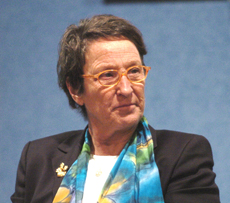 |
|
Joke Waller-Hunter, UNFCCC Executive
Secretary, stressed that IPCC’s input
helped reaching the Marrakesh agreement
on LULUCF |
|
Rajendra Pauchari, IPCC Chairman,
described IPCC’s mandate, noting
that its main purpose is to provide
comprehensive scientific assessments
that are relevant to policy makers
without being prescriptive. He said
the highly selective process of
assigning experts to the IPCC
enhances the quality of the IPCC’s
work.
Joke Waller-Hunter, UNFCCC Executive
Secretary, said the IPCC is an
authoritative, relevant and
policy-neutral body whose work is at
the core of the international
climate policy process. She
highlighted IPCC’s contributions on
land use, land-use change, and
forestry (LULUCF), and
methodological guidance regarding
greenhouse gas (GHG) inventories.
Waller-Hunter said the IPCC’s first
assessment report set the stage for
initial negotiations, the second
assassment report established the
possibility of addressing climate
change without serious economic
impacts, and the third assessment
report further provided information
on concentrations of individual GHGs.
|
|
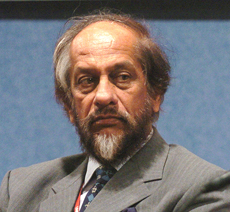 |
|
Rajendra Pauchari, IPCC Chair, discussed
outstanding scientific issues, and said
the cost of inaction is not only
monetary but also involves loss of human
lives and ecological disruption that
cannot be quantified |
|
Renate Christ, IPCC, outlined the
structure of the IPCC, noting that
it consists of working groups on
scientific basis, impacts and
adaptation, and mitigation. She
reviewed the main findings of each
working group contained in the
assessments, and stressed that the
assessment reports contributed two
agenda items to the Subsidiary Body
for Scientific and Technological
Advice (SBSTA).
Harald Dovland, Norwegian Ministry
of the Environment, discussed the
role of science in policy making,
noting that the IPCC’s assessment
reports preceded the adoption of the
UNFCCC, the Kyoto Protocol and the
addition of two new SBSTA items,
respectively. He highlighted IPCC’s
contributions to good practice
guidance and emissions guidelines,
expressed concern over the number of
SBSTA members attending IPCC
meetings, noted the risk of
politicizing the IPCC, and called
for further simplifying the language
of assessment reports.
Osvaldo Canziani, Co-Chair of the
working group on vulnerability,
impacts and adaptation, discussed
his working group’s contribution to
the IPCC’s
|
|
third assessment
report issued in
2001. He said the
impacts of climate
change are easy to
observe but
attributing strict
causality is
difficult. Canziani
highlighted the
concept of critical
threshold
temperatures that
may lead to
irreversible
ecological
destruction, and
stressed the need to
further investigate:
causal links between
climate change and
ostensible climate
impacts;
vulnerability to
climate change; and
climate effects
under different
development paths.
Hans Holger-Rogner,
International Atomic
Energy Agency, said
the task of the
working group on
mitigation is to
assess information
on mitigation
options, and
stressed the need to
distinguish between
long-term and
short-term effects
of mitigation, as
well as between
technical, economic
and social aspects
of mitigation
options. He said
specific policies
need to be tailored
to national and
local circumstances,
but must mainstream
mitigation in
sustainable
development as well
as address
cross-cutting
issues.
Taka Hiraishi,
Co-Chair of IPCC’s
National GHG
Inventories
Programme (NGGIP),
outlined NGGIP’s
work on developing
internationally
agreed methodology
for the calculation
and reporting of
national GHG
emissions. He noted
that the 2003 Good
Practice Guidance
for LULUCF is being
revised for 2006.
Discussion: Pauchari
indicated that the
IPCC reports are not
subject to external
evaluation and are
often misinterpreted
in the press.
Regarding the fourth
assessment report
due in 2007, he said
the working group on
basic science needs
to reduce key
scientific
uncertainties. He
noted that the cost
of inaction cannot
be quantified in
monetary terms only,
and that the cost of
action is often
exaggerated.
|
|
|
The practical consequences of climate
equity: Toward a relevant equity
reference framework
Presented by the Tellus Institute
|
|
|
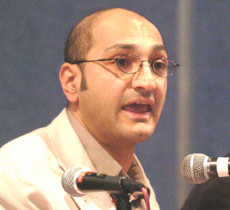 |
|
Sivan Kartha, Tellus Institute, said
future climate commitments should
consider both responsibility and
capacity, which involves addressing
emissions and wealth |
|
Paul Baer, Berkeley
Energy and Resources
Group, advocated a
precautionary
approach to climate
change, noting that
limiting
temperatures rise
below 2°C requires
stabilizing GHG
concentrations at
400 parts per
million (ppm) rather
than 550 ppm.
Tom Athanasiou,
EcoEquity,
introduced “the
Gordian knot”
analytical
framework, based on
adequacy, realism
and equity,
emphasizing that
adequacy should be
assessed without
prejudging what is
realistic or fair.
He said the South is
justified in
insisting on the
right to sustainable
development without
having to commit to
mitigation measures.
Sivan Kartha, Tellus
Institute, endorsed
the idea of a
development
threshold, dividing
countries into those
responsible for
mitigation and those
entitled to
prioritize
development. He said
due to class and
wealth divisions in
the South, the
threshold may not be
national income but
some other
indicator.
Sarah Hendry, UK
Department for
Environment, Food
and Rural Affairs, |
|
stressed the
importance of
creating an
environment for
discussions, where
views can be freely
expressed without
the fear of
committing to future
actions.
Chandrashehkar
Dasgupta, the Energy
and Resources
Institute (Teri),
highlighted the
balance reflected in
UNFCCC Article 2
(Objective). He
stressed that new
commitments should
not compromise other
objectives of the
Convention,
including
sustainable economic
development. He
objected to the idea
of a development
threshold, saying it
would condemn large
parts of the world’s
population to
poverty.
Agus Pratama Sari,
Pelangi/Indonesian
Delegate, emphasized
that the distinction
between developed
and developing
countries is a
political one that
masks more complex
realities. He said
conflicting
interests within
countries should be
the starting point
for discussing
future commitments,
and cautioned that
the right to
development should
be carefully
analyzed to
determine whether it
is invoked genuinely
or as rhetoric by
Southern elites
seeking to avoid
changes to their
comfortable
lifestyles.
Jennifer Morgan,
World Wildlife Fund
for Nature,
emphasized the need
for new ideas and
social debate on the
adequacy of climate
commitments. She
highlighted the role
of vested interests
in climate politics,
saying that the cost
of achieving the 2°C
temperature rise
maximum limit would
not necessarily be
very high.
|
|
|
Book launch: A guide to the
international climate change regime
Presented by the Institute of
Development Studies (IDS), University of
Sussex
|
|
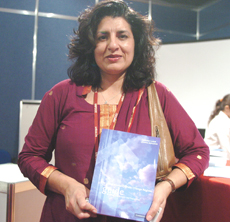 |
|
Richard Bradley, IEA, said a sustainable
energy system requires more rapid
technology transfer |
|
Farhana Yamin, IDS, launched the
book International Climate Change
Regime: A Guide to Rules,
Institutions and Procedures,
co-authored with Joanna Depledge,
University of Cambridge. She said
the book is a comprehensive and
objective account of the rules,
institutions and procedures
governing the international climate
change regime. She explained that
the book covers the UNFCCC, the
Kyoto Protocol, the Marrakesh
Accords and all decisions by the
Conference of the Parties (COP) up
to COP-9. She noted the complexity
of the climate change negotiations,
and said the book attempts to
clarify how the regime functions and
what its rules are. She highlighted
that the book covers various aspects
of the climate change regime, and
includes a discussion on political
coalitions, institutional structure,
negotiations and linkages with other
regimes. She emphasized the
opportunity to celebrate the
existence of two legally binding
international climate treaties.
Richard Kinley, UNFCCC Secretariat,
said the book makes an important
contribution to understanding how
the climate regime works that will |
|
benefit delegates, scholars
and a variety of
stakeholders.
|
|
Facts and trends to 2050: Energy and
climate change
Presented by the World Business Council
for Sustainable Development (WBCSD)
|
|
 |
|
Laurent Corbier, WBCSD, presented the
new report “Facts and trends to 2050 –
Energy and climate change,” and stressed
the magnitude of the challenge of
cutting future carbon emissions |
|
Laurent Corbier, WBCSD, introduced
his organization, a coalition of 175
international companies from 35
countries, and outlined its work
program for 2004. He said facts and
trends provided in a new WBCSD
report are the basis for his
organization’s future work on
policies, business responses and
tools.
William Kyte Obe, Eon, emphasized
that, for the business community,
climate change is only one of many
concerns, and stressed the need to
communicate climate change-related
issues in a language that is
understandable by top business
executives. He called for long-term
signals by policy makers and for
setting a price for carbon, noting
that the market will find solutions
if appropriate prices are set.
David Hone, Shell International,
introduced the publication “Facts
and trends to 2050 - Energy and
climate change,” which comprises
sections on energy demand, climate
impacts, technological change, and
the future challenge. Presenting
energy data of the International
Energy Agency and IPCC climate
change scenarios, he noted that
energy demand will double
|
or triple over the next 50 years,
and that carbon emissions have to be
reduced by seven giga tons by 2050.
He discussed the lifespan of energy
infrastructure, noting that the
necessary transition toward a low
carbon economy will take time.
Mark Akhurst, BP, compared existing
technological options in the power
and transport sectors by examining
the consequences of reducing one
giga ton of carbon using different
technologies. He emphasized that
these technologies are already
deployed, but none of them could
solve the problem alone, noting that
a mix of technological measures was
needed.
Discussion: A participant said the
presentations focused on
technological potentials, without
addressing the specific barriers to
rapid diffusion of these
technologies. Panelists responded
that future work will elaborate on
policies and frameworks.
|
|
The climate change and air quality nexus
Presented by the International Council
for Local Environmental Initiatives (ICLEI)
|
|
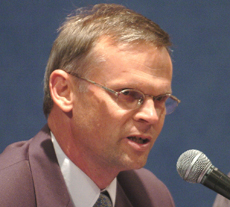 |
|
Dieter Wartchow, City Hall of Porto
Alegre, Brazil, stressed the need to
promote household energy efficiency |
|
Rocky Anderson, Mayor of Salt Lake
City, US, said since the US federal
government is not leading to address
climate change, leadership must be
exercised at the local level.
Highlighting links between global
warming and local air quality, he
said 60% of air pollution in the
Salt Lake Valley comes from
automobile use. He said his city
aims to meet or exceed a 7% GHG
emissions reduction compared to the
1990 baseline, and described how
these reductions will be achieved
through energy conservation and a
shift to renewable energy. He
described a number of transport
initiatives, including the
introduction of compressed-natural
gas vehicles, promotion of public
transport, and expansion of bicycle
lanes.
Dieter Wartchow, City Hall of Porto
Alegre, Brazil, highlighted the need
for effective social management of
environmental resources, stressing
the need for environmental education
to encourage public participation in
emissions reduction initiatives.
Indicating that the transport sector
is responsible for 65% of energy
consumption in Porto Alegre, he
described |
|
efforts to increase bicycle lane
coverage and promote cleaner fuels.
He outlined local efforts to promote
energy efficiency and renewable
energy use, highlighting economic
benefits. He described EcoPark, a
public-private partnership that aims
to capture methane emissions from
municipal waste.
Ryan Bell, ICLEI, introduced the
Harmonized Emissions Analysis Tool
(HEAT), a multilingual internet
database for storing, tracking and
reporting GHG emissions and offering
criteria on air pollutants. He
explained that HEAT will enable
local governments to conduct
emissions analyses, and predict
future emissions and emissions
reductions associated with projects.
He indicated that HEAT will allow
for analyses of emissions variations
between jurisdictions with different
geography, demography, development
levels and economic profiles. |
|
Innovative partnerships to address
climate change
Presented by the US Government
|
|
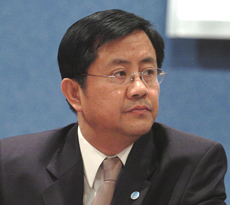 |
|
Gao Feng, China’s Ministry of Foreign
Affairs, stressed that partnerships are
important for implementation of the
UNFCCC |
|
Paula Dobriansky, US Department of
State, indicated that the Bush
administration is providing economic
incentives for energy-efficient
technologies and US$4.1 billion in
tax credits for emissions
reductions. She explained that the
US has bilateral relations with 14
countries to address climate change,
resulting in over 200 projects
around the world.
Altero Mattioli, Italy’s Minister
for the Environment and Land
Protection, stressed the need to
disseminate low carbon technologies
and promote the use of renewable
energies. He outlined two
initiatives undertaken in
cooperation with the US: one that
promotes the use of renewable energy
in the Mediterranean region; and a
second that involves creating
gardens in Mesopotamia.
Prodipto Ghosh, India’s Ministry of
Environment and Forests, indicated
that his country collaborates with
the US to promote a wide range of
climate-friendly technologies. He
stressed that partnerships do not
represent uni-directional flows of
technologies and resources, but
entail |
|
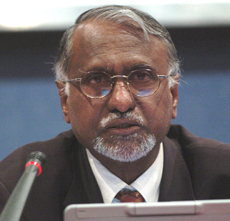 |
|
Prodipto Ghosh, India’s Ministry of
Environment and Forests, stressed that
his country’s partnerships with the US
follow the principle of common but
differentiated responsibilities |
|
contributions
from both sides.
Gao Feng,
China’s Ministry
of Foreign
Affairs, noted
that bilateral
consultations on
climate change
are underway
between China
and the US. He
said high
investment will
be made in the
energy sector in
China in the
near future,
indicating the
intention to
build 100
nuclear power
plants in the
next 20 years.
Conrad
Lautenbacher, US
National Oceanic
and Atmospheric
Administration,
outlined a
number of
research
programs and
partnerships
related to
climate change.
He highlighted
the Climate
Change Science
Program, noting
that it seeks to
improve
knowledge of
climate and the
environment,
quantify forces
driving climate
change, reduce
uncertainty in
projections of
future climate
change, and
understand the
adaptability of
ecosystems.
Judith Ayers, US
Environmental
Protection
Agency,
described the
“methane to
markets
partnership,”
which brings
countries
together to
reduce methane
emissions from
coal mines, oil
and gas systems
and |
|
landfills. She said the
project provides cost-effective
methane recovery for use as an
energy source.
Jacqueline Schafer, US Agency for
International Development, noted
that her organization places an
emphasis on partnerships in
addressing a wide range of climate
change issues.
Stephen Eule, US Department of
Energy, said well designed
collaborations can accelerate the
development and implementation of
cleaner energy technologies. He
highlighted the Generation IV
International Forum, saying it is
concerned with promoting the fourth
generation of advanced nuclear
systems. He highlighted the need for
strong private sector participation.
Discussion: Participants raised
questions regarding the lack of
market incentives for carbon
sequestration, programs aimed at
indigenous communities, the impacts
of rising oil prices on climate
technology markets, and the
promotion of available alternative
energy technologies in the short
term. |
|
Climate change: Issues and approaches
Presented by the International Petroleum
Industry Environmental Conservation
Association (IPIECA)
|
|
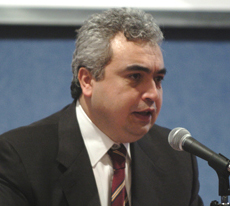 |
|
Fatih Birol, IEA, called for strong
policies that promote alternative energy
technologies |
|
Richard Sykes, Shell International,
said the IPIECA and its working
group on climate change had
organized workshops for its member
companies on, inter alia, long-term
carbon management, carbon storage,
and guidelines for reporting GHG
emissions.
Fatih Birol, International Energy
Agency (IEA), presented the World
Energy Outlook 2004, highlighting
that 90% of the increase in oil
demand in OECD countries until 2030
will occur in the transport sector.
He noted that the average carbon
content of primary energy will
increase slightly through 2030 due
to a decline in the share of nuclear
power in the world’s energy market,
and called for faster technology
development and deployment. He said
according to IEA’s forecasts, the
number of people without access to
electricity will decline from
today’s 1.6 billion to 1.4 billion
people in 2030.
Mark Akhurst, BP, presented
conclusions and recommendations from
an |
|
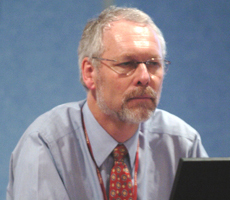 |
|
Fatih Birol, IEA, called for strong
policies that promote alternative energy
technologies |
|
IPIECA workshop on long-term carbon
and energy management, held in 2001,
stating that fossil fuel
availability will not be a concern
over the next decades. On long-term
policies, Akhurst said clear
guidelines are needed, which take
into account the fact that
technologies must be efficient and
economic.
Frede Cappelen, Statoil, said
climate change is not a near-term
priority in Asia and Latin America,
noting that key issues in these
regions include sustainable
development, poverty alleviation and
affordable energy. He stressed that
the Clean Development Mechanism (CDM)
would offer one pathway to
technology transfer, but lamented
the complicated approval criteria
and the weak capacity of the CDM
Executive Board, which discourage
the development of large-scale
projects by the private sector.
Robert Greco III, American Petroleum
Institute, discussed a workshop on |
the transport sector, noting
that the cost of fuel provides a
large economic driver to improve
efficiency. He identified
trade-offs between primary
energy consumption and GHG
emissions for biofuels, noting
that mobility is critical for
development.
Arthur Lee, ChevronTexacon
Corporation, identified a large
technical potential for carbon
dioxide capture and geological
storage (CCS), noting that
current costs of CCS from power
plants are from US$40-60 per ton
of carbon dioxide. On risk
management for CCS, Lee stressed
the importance of site
selection, safe operations,
operational monitoring and
storage time. |
Latest climate change results from the
Hadley Centre
Presented by the Hadley Centre
|
 |
|
Margaret Beckett, UK Secretary of State
for the Environment, Food and Rural
Affairs, said the Hadley Centre works to
improve understanding of uncertainties
and prediction of climatic extremes |
|
Margaret Beckett, UK Secretary of
State for the Environment, Food and
Rural Affairs, introduced the Hadley
Centre’s work on reducing
uncertainty and improving prediction
of extreme climatic events. Noting
lingering uncertainty, she
highlighted findings that existing
GHG in the atmosphere have already
increased the likelihood of extreme
weather events.
David Griggs, Hadley Centre,
discussed uncertainty, risk and
climate change. He said the global
average temperature has risen by
0.7°C between 1861 and 2003, 2003
was the third warmest year on
record, and the ten warmest years
occurred after 1990. He discussed
uncertainty stemming from complex
interactions between multiple
variables such as future emissions
and cloud cover, and presented the
Hadley Centre’s new technique for
estimating climate model
uncertainty.
Vicky Pope, Hadley Centre, reviewed
changes in weather extremes, the |
|
|
possibility of a Gulf Stream
collapse, projected melting of
Greenland’s ice sheet and the
probability of severe heat waves.
She said doubling carbon dioxide
concentrations in the atmosphere
would entail a 3-4°C increase in
mean temperature and a 3°C increase
in extreme temperature for
Washington D.C., as well as a
decrease in precipitation and
rainforest decline in Amazonia.
Regarding Gulf Stream dynamics, she
said thermohaline circulation (THC)
has shut down in the past, leading
to dramatic cooling in the Northern
hemisphere. She indicated that
another shutdown would result in
winter temperatures in London
equivalent to those in Moscow.
Noting that Greenland’s ice sheet is
3200 meters thick, Pope said local
warming of 2.7°C in Greenland would
trigger considerable ice meltdown
over the next 1000 years. She added
that human influence has more than
doubled the risk of heat waves of
the magnitude seen in Europe in the
summer of 2003.
Discussion: Griggs stressed
significant uncertainties regarding
the possible implications of THC
shutdown for regional sea level
rise, cloud cover and the connection
between El Niño and global climate
change. |
|
|
|







